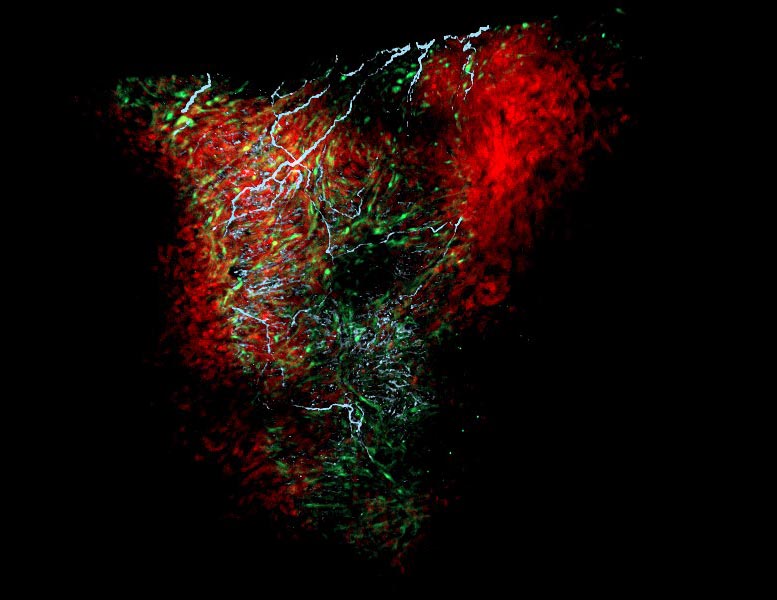
Discovery suggests glial cells may be important in other organs as well.
Glial cells in the heart help regulate heart rate and rhythm, and drive its development in the embryo, according to a new study publishing today (November 18th, 2021) in the open-access journal PLOS Biology by Nina Kikel-Coury, Cody Smith and colleagues at the University of Notre Dame. The discovery provides the most detailed portrait yet of a critical population of cells that had been previously poorly understood.
Glia are a diverse set of cell types, originally named after the Greek word for glue, and include cells that surround and nourish neurons, and others that mount immune responses within the central nervous system. In the peripheral nervous system, glia are present and presumably active in multiple organs, including the gut, pancreas, spleen, and lungs, although their function is not clear in most cases.
Recently, a cell population in the heart that expresses a known astroglial marker has been reported, and a part of the developing heart called the outflow tract includes a group of cells derived from an embryonic structure called the neural crest, which is the source of most peripheral glial cells.
These intriguing clues led the authors to look more deeply at the identity and function of these cells. Beginning in zebrafish, they found an abundant group of cells in the heart’s ventricles that produced glial fibrillary acid protein (GFAP), a classic marker of glia. GFAP-positive cells were also found in the hearts of mice and humans. Those cells were concentrated in the so-called outflow tract in early development, a structure that forms in the heart during development and contributes to the pathway that connects the ventricles to the arteries leaving the heart. Killing these cells increased the rate of nerve development in the embryonic heart, suggesting they play an inhibitory or delaying role in cardiac innervation. By a variety of methods, including tracking individually labeled cells as they migrated, the researchers showed that the glial cells that take up residence in the outflow tract begin their journey in the neural crest. They termed these cells nexus glia.
Glia’s Role in Heart Rhythm Regulation
But what is the role of these glial cells in the mature heart? When the authors removed the cells, the heart rate increased; when the cells were reduced by depriving them of a key gene that drives their glial development, the resulting heart beat irregularly. A major subdivision of the peripheral nervous system, called the autonomic system, regulates many aspects of physiology, including heart rate, through its two branches, the sympathetic and parasympathetic systems. By treating zebrafish with chemicals that increase activity of one branch or another, they showed that cardiac glia control heart rate through their modulation of both branches.
The results greatly expand the understanding of the role of glial cells in the heart and suggest that glia may also play critical roles in the development and function of other organs where they have been glimpsed. “Our findings indicate an extensive and under-explored network of organ-associated glia that have functional roles dependent upon the environment,” Smith said. “Further understanding of these specialized astroglial populations is therefore necessary, given their potential impact on organ physiology.”
Smith adds, “Astrocyte-like cells in the PNS are poorly understood. We show that an astrocyte-like cell functions early in development to regulate autonomic-nervous system control of the heart.”
Reference: “Identification of astroglia-like cardiac nexus glia that are critical regulators of cardiac development and function” by Nina L. Kikel-Coury, Jacob P. Brandt, Isabel A. Correia, Michael R. O’Dea, Dana F. DeSantis, Felicity Sterling, Kevin Vaughan, Gulberk Ozcebe, Pinar Zorlutuna and Cody J. Smith, 18 November 2021, PLOS Biology.
DOI: 10.1371/journal.pbio.3001444
Funding: This work was supported by the University of Notre Dame, the Elizabeth and Michael Gallagher Family (CJS), Centers for Zebrafish Research and Stem Cells Regenerative Medicine at the University of Notre Dame (CJS), the Alfred P. Sloan Foundation (FG-2017-9531)(CJS) and the National Institute of Health (DP2NS117177)(CJS). The funders had no role in study design, data collection and analysis, decision to publish, or preparation of the manuscript.
Never miss a breakthrough: Join the SciTechDaily newsletter.